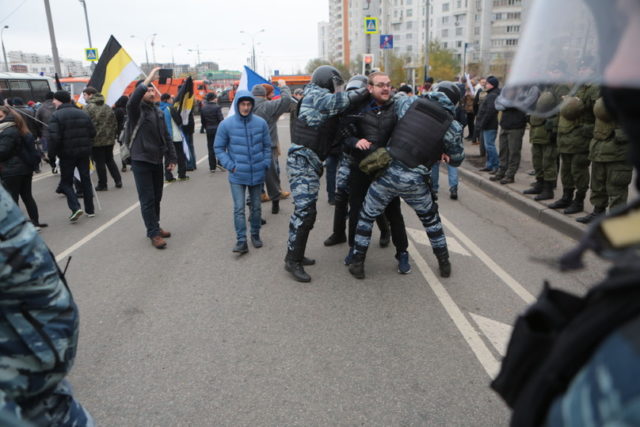
Russian March 2017: Smaller Than in Years Past, but More Likely to Attract Youth
Publication: Eurasia Daily Monitor Volume: 14 Issue: 142
By:

The annual “Russian March” on November 4 (National Unity Day) has become a rallying point for the nationalist opposition to the regime. And this year, the event took on special significance because of its proximity to the 100-year anniversary of the Bolshevik Revolution on November 7. Preparatory announcements about the march itself, posted on the extreme-right website of the Committee for Nation and Freedom, seemed to promise parades in Moscow, St. Petersburg, Ekaterinburg, Vologda and Pskov, all of which were to call for the resignation of President Vladimir Putin (Komitetns.org, October 25). The post further went on to list ways in which people could help even if they did not have the opportunity to participate in marches in their own cities.
The main event in Moscow took the form of two separate marches—one in the southeastern working class suburb of Lublino and the other in northwestern area of the capital, which began at the Oktyabrskoye Pole metro station. The Lublino march gathered about 200 people (despite earlier claims that it would attract 10,000) but was swiftly shut down due to some supposedly unsanctioned banners and slogans on display in the parade. The organizers had earlier claimed that their slogans and route for the march had been pre-approved by the authorities. One of the main coordinators, Ivan Beletski, had his house searched by the police in connection with another criminal case in which he is involved, although he believes the timing of the search was motivated by the Russian March. The other main organizer, Yuri Gorski, is currently in Lithuania, living in self-imposed political exile. In all, 32 people were arrested in Lublino (Gazeta.ru, November 4). According to the human rights organization SOVA, there were numerous neo-Nazi Celtic Cross symbols on display as demonstrators came out into the streets. Several far-right nationalist groups were in attendance, including the Russian Human Rights League, the Association of Popular Resistance, the Black Bloc and the National-Revolutionary Avant-Garde (Sova-center.ru, November 5).
The march in northwestern Moscow, traditionally a more moderate alternative to the nationalist-opposition march in Lublino—established by the authorities to co-opt the movement and drain its popular support—did go ahead and saw 370 people march to Shukinskoi. For the first time, then, the march organized by the authorities attracted more people than that independently organized by the nationalist opposition. Organizations present at the sanctioned march included groups promoting the right to bear arms in Russia, anti-abortion activists, and various movements celebrating Russia’s interference in Ukraine. The former Liberal Democratic Party of Russia (LDPR) deputy Nikolai Kurianovich also attended the march and used a loudspeaker to shout slogans to the participants (Sova-center.ru, November 5). During the march, protesters held up signs such as “Natural wealth is the property of the people!”; “Orthodox families of Russia are our salvation!”; and “Down with the oligarchs! We are in favor of democracy, nationalization, and de-privatization of Russia’s resources!” (Gazeta.ru, November 4).
Revolutionary zeal was more in evidence on Sunday, November 5, when the police searched homes and arrested activists who were working on behalf of exiled opposition politician Vyacheslav Maltsev and his banned movement Artpodgotovka (“Suppressive Fire”). The police and the Federal Security Service (FSB) conducted more than 20 searches in Moscow and the region, ostensibly on the tip that Artpodgotovka was planning to set fire to administrative buildings. Other reports suggest that the police found numerous individuals with traumatic (blank-firing) weapons and brass knuckles (knuckledusters) and for these reasons closed the entrance to Red Square (Moskovsky Komsomlets, November 5). Although Maltsev had allegedly been calling for revolution online, virtually no one in Russia took the threat seriously. Hence, the actions of the authorities seems to have been massively disproportionate—further evidence of heightened sensitivity before the centennial of the Bolshevik Revolution on Tuesday.
Unity Day marches were also organized outside Moscow. In St. Petersburg, a small column of perhaps 30 nationalists gathered outside the Sportivnaya metro station and began to march. Strict policing was similarly in evidence here: reportedly, there were more riot police out than marchers, and an early arrest included a youth who was cursing loudly (Fontanka.ru, November 4). In Ekaterinburg, video evidence showed a rally of maybe 100 nationalists (although there were surely more not captured in the clip) waving the imperial Russian flag and carrying a sign reading “Down with the occupation! Down with 282,” a reference to the fact some nationalists look at Putin’s regime as a hostile occupying force that represses nationalism through the clause of the legal code (No. 282) that prohibits incitement to extremism (YouTube, November 4). In Novosibersk, where several years ago the Russian March had attracted more than 1,000 people, the authorities banned the nationalist march; although they permitted a pro-regime march to go ahead. Nevertheless, some protesters—perhaps no more than 100—did turn up at the agreed-upon nationalists’ meeting spot. There, they were told by police that the Russian March had not been approved and so they had to continue without the display of any symbols. Most of the marchers were young people (Bk54.ru, November 4)—exactly the age group Alexei Navalny has succeeded in bringing out to oppose the regime on several occasions earlier this year (see EDM, March 27, June 15, October 11). Similar events also occurred in other cities, large and small, across Russia.
The Russian March in 2017 suggests two insights into Russian politics. First, despite the authorities’ efforts to repress the march, the will to resist still seems to be present in Russian society, especially amongst the young. Second, the regime is clearly taking no chances and is cracking down hard on any popular mobilization in the run-up to next year’s presidential election, scheduled for March 2018. The ghost of November 7, 1917, thus haunts the corridors of the Kremlin.



